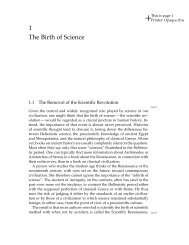Create successful ePaper yourself
Turn your PDF publications into a flip-book with our unique Google optimized e-Paper software.
Summer Graduate Workshop: Toric Varieties<br />
The <strong>MSRI</strong> summer graduate workshop on toric varieties, organized<br />
by David Cox of Amherst College and Hal Schenck of the University<br />
of Illinois at Urbana-Campaign, took place June 15–26,<br />
and brought together a diverse group of 45 participants, ranging<br />
from first- through fifth-year graduate students, with backgrounds<br />
in combinatorics, algebraic and symplectic geometry, and commutative<br />
algebra. Toric varieties are a class of algebraic varieties<br />
(roughly speaking, objects which look locally like the zeroes of<br />
a system of polynomial equations) which lie at the interface of<br />
geometry, combinatorics and algebra. The class of toric varieties<br />
is both large enough to include a wide range of phenomena and<br />
concrete enough to provide an excellent computational environment.<br />
This atypical combination leads to applications in many<br />
other fields including string theory, coding theory, approximation<br />
theory and statistics. Toric varieties also provide a wonderful vehicle<br />
for teaching algebraic geometry.<br />
Geometrically, a toric variety is an irreducible algebraic set in<br />
which an algebraic torus forms a dense open subset, such that the<br />
action of the torus on itself extends to an action on the entire set.<br />
Combinatorially, a normal toric variety is determined by a fan;<br />
the cones in the fan yield affine varieties and the intersection of<br />
cones provides gluing data needed to assemble these affine pieces<br />
together. Algebraically, an embedded toric variety corresponds to<br />
a prime binomial ideal in a polynomial ring. More generally, a<br />
toric variety can be described by a multigraded ring together with<br />
an irrelevant ideal. The importance of toric varieties comes from<br />
this dictionary between algebraic spaces, discrete geometric objects<br />
such as cones and polytopes, and multigraded commutative<br />
algebra.<br />
Because of the wide range of backgrounds, the workshop had a<br />
very intense schedule. In the evenings, there were background lectures<br />
on basic material in algebraic geometry (ranging, for example,<br />
from valuation rings to vector bundles to sheaf cohomology).<br />
Each morning, there were two one-hour lectures on interpreting<br />
algebro-geometric concepts in the toric setting. After lunch, participants<br />
were presented with several different sets of problems,<br />
ranging from very computational (compute the Picard group of a<br />
Hirzebruch surface) to more theoretical (prove a lemma stated during<br />
the morning lecture). Participants broke up into small groups of<br />
six or seven people, helped when needed by the organizers and two<br />
very able TAs (Dustin Cartwright and Daniel Erman) from Berkeley.<br />
At the end of the afternoon, the groups presented their results<br />
to the whole workshop.<br />
During the latter part of the second week, three guest speakers<br />
spoke on topics related to toric geometry: David Eisenbud on the<br />
cone of betti tables; Matthias Beck on normality and semigroups;<br />
and Sam Payne on toric vector bundles. Participants really enjoyed<br />
seeing research talks on topics they had just studied. Here are some<br />
of their comments:<br />
“The workshop was a truly amazing experience. The only way to<br />
improve it would be to make it longer!”<br />
“I can’t believe how much I learned in these short two weeks.”<br />
“Excellent workshop. The problem sessions and presentation setup<br />
were very conducive to working together and understanding the<br />
material. Intensive but also fun.”<br />
“The format of the workshop, although incredibly intensive, was<br />
very effective. Although there was no way for me to have digested<br />
everything, I learned a lot. Also, I really enjoyed the problem sessions<br />
because it encouraged us to meet each other and socialize.”<br />
“The morning lectures gave us the big picture. The afternoon problem<br />
sessions filled in the details of the picture; I particularly enjoyed<br />
the group work. The evening lectures helped prepare us for<br />
the next day’s topics. This was an awesome experience.”<br />
Kuei-Nuan Lin (Purdue) and Swarnava Mukhopadhyay (UNC) at the summer workshop. Workshop lectures are available on<br />
streaming video at http://www.msri.org/calendar/sgw/WorkshopInfo/455/show_sgw. A draft of the forthcoming AMS book<br />
Toric Varieties by Cox, Little and Schenck is available at http://www.cs.amherst.edu/ dac/toric.html.<br />
13










